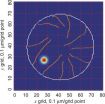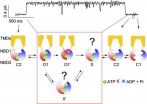(Press-News.org) High biodiversity acts as an insurance policy for nature and society alike as it increases the likelihood that at least some species will be sufficiently resilient to sustain important functions such as water purification and crop pollination in a changing environment.
"It's the same principle as an investment portfolio – you'd be mad to put all your eggs in one basket," says researcher Johan Eklöf.
Experiments with eelgrass meadows in shallow inlets on the west coast of Sweden are now showing that climate change can exacerbate the negative effects of losing sensitive species, and that the insurance effect of biodiversity may be weaker than what we typically assume.
Eelgrass meadows in shallow inlets are important nursery habitats for cod, for example. Since the early 1980s the prevalence of eelgrass has fallen dramatically along the Bohuslän coast.
This is thought to be due partly to eutrophication, which favours mats of filamentous "nuisance" algae which shade and suffocate the eelgrass, and partly to the loss of cod, which has resulted in a huge increase in numbers of smaller predatory fish. These predatory fish, in turn, reduce numbers of Grammarus locusta, herbivorous crustaceans which are effective grazers that normally control the filamentous algae.
This type of cascade effect has become increasingly common both onshore and off as many types of predator have been wiped out by hunting or fishing. Worryingly, theory and observations would indicate that these effects could magnify the effects of global warming, which favours heat-tolerant but grazing-sensitive plants such as filamentous algae.
At the Sven Lovén Centre for Marine Sciences' Kristineberg research station on Gullmarsfjorden, researchers from the University of Gothenburg's Department of Biology and Environmental Sciences have developed miniature ecosystems in outdoor aquariums and have been investigating how future ocean warming and ocean acidification could affect the balance between eelgrass and filamentous algae.
The effects were unexpectedly clear and unambiguous: it was the diversity of algal herbivores that determined the extent to which the ecosystem was affected by warming and acidification.
"High diversity meant that neither warming nor acidification had any real effect as the algae were eaten before they managed to grow and shade the eelgrass," says researcher and biologist Johan Eklöf, who headed up the study. "But when we simultaneously simulated the effects of fishing and removed the effective but vulnerable herbivor Grammarus locusta, the algae took over the ecosystem – especially in the warmer conditions."
The researchers believe that we should be concerned about the results.
"Most management is based on the assumption that we afford to lose the most sensitive species because other, more resilient species will take their place," says Johan Eklöf. "But this may not be the case with future climate changes, as it can reduce the net efficiency of the resilient species – without directly affecting them."
However, the researchers are also careful to point out that there is still hope if society does decide to take action.
"If we protect the local biodiversity we still have, and restore the diversity we've lost, by for example protecting predatory fish stocks in coastal areas and reducing nutrient loading, then we'll probably be able to increase the ecosystems' resilience to climate change."
### Contact: Johan Eklöf
46 707-38 43 15
johane@ecology.su.se
Loss of species makes nature more sensitive to climate change
2012-09-26
ELSE PRESS RELEASES FROM THIS DATE:
Geometry plays a role in GPCR transmembrane signaling
2012-09-26
A recent study in The Journal of General Physiology characterizes the movement of rhodopsin, a GPCR and member of a large family of transmembrane receptors responsible for many cellular responses and involved in many human diseases.
In living Xenopus rod photoreceptor cells, rhodopsin is found in stacks of disc membranes that are difficult to study due to their small size. Now, Peter Calvert (SUNY Upstate Medical University) and colleagues have developed an approach with two-photon microscopy that, for the first time, allows direct examination within the living cell ...
University of Kentucky research sheds light on pain pill abuse
2012-09-26
LEXINGTON, Ky. (Sept. 26, 2012) — A study by a team of University of Kentucky researchers has shed new light on the potential habit-forming properties of the popular pain medication tramadol, in research funded by the National Institute on Drug Abuse. The paper is slated to appear in an upcoming edition of the academic journal Psychopharmacology.
Prescription pain killer abuse is a major public health problem in the U.S. In 2010, more individuals over the age of 12 reported nonmedical use of prescription pain relievers in the past month than use of cocaine, methamphetamine ...
New insights into functionality of cystic fibrosis protein
2012-09-26
CFTR is an important protein that, when mutated, causes the life-threatening genetic disease cystic fibrosis. A study in The Journal of General Physiology (JGP) details how an accidental discovery has provided new understanding about CFTR functionality.
From a scientific standpoint, CFTR is unique in that it is the only known ion channel—a protein pore that enables the passive diffusion of ions across cell membranes—in the enormous superfamily of ABC proteins, which normally operate as active transporters. As active transporters, ABC proteins use energy derived from ...
Paper: Federal law needed to safeguard 'digital afterlives'
2012-09-26
CHAMPAIGN, Ill. – Federal law ought to play a stronger role in regulating social networking sites by allowing users to determine what happens to their "digital afterlives," says a recently published paper by a University of Illinois expert in intellectual property law.
Allowing social networking sites to set their own policies regarding the content associated with the accounts of deceased users does not adequately protect individual and collective interests, especially with people spending an increasing part of their lives online using social networking sites, says Jason ...
Duke Medicine news -- Protein structure unlocks 1 mystery of multi-drug tolerance
2012-09-26
DURHAM, N.C. – The structures of key bacterial proteins have revealed one of the biochemical secrets that enables bacteria to outwit antibiotics.
In a paper published Sept. 20, 2012 in the journal Cell Reports, Duke University School of Medicine researchers and their colleagues describe the results of a series of experiments exploring multi-drug tolerance, a phenomenon that allows bacteria to become dormant and tolerate antibiotics, only to later awaken and re-infect the host. Drug tolerance is a factor in several types of stubborn, recurring infectious diseases caused ...
Taking the battle against the toxic trio beyond 'Leaves of 3, leave it be'
2012-09-26
With more than half of all adults allergic to poison ivy, oak and sumac, scientists are reporting an advance toward an inexpensive spray that could reveal the presence of the rash-causing toxic oil on the skin, clothing, garden tools, and even the family cat or dog. Using the spray, described in ACS' The Journal of Organic Chemistry would enable people to wash off the oil, or avoid further contact, in time to sidestep days of misery.
Rebecca Braslau and colleagues explain that allergic reactions to oils of the toxic trio are more than a nusiance. They claim a huge human ...
Bigger wind turbines make greener electricity
2012-09-26
WASHINGTON, Sept. 26, 2012 — The latest episode in the American Chemical Society's (ACS') award-winning Global Challenges/Chemistry Solutions podcast series concludes that the larger the wind turbine, the greener the electricity it produces. The study could solidify the trend toward construction of gigantic windmills.
Based on a report by Marloes Caduff in ACS' journal Environmental Science & Technology, the new podcast is available without charge at iTunes and from www.acs.org/globalchallenges.
In the new episode, Caduff, a graduate student, and Stefanie Hellweg, ...
Exposure to snot-nosed kids ups severity of cold infections
2012-09-26
Exposure to school-age children raises the odds that a person with lung disease who catches a cold will actually suffer symptoms like a runny nose, sore throat and cough, according to a study just published in the Journal of Clinical Virology.
That finding, the result of a study that drew upon a databank of 1,000 samples of sputum and nasal secretions from people with chronic obstructive pulmonary disease or COPD, comes as a surprise, says Ann Falsey, M.D., professor of Medicine at the University of Rochester and an infectious disease expert at Rochester General Hospital. ...
Buddhist statue, discovered by Nazi expedition, is made of meteorite, new study reveals
2012-09-26
It sounds like an artifact from an Indiana Jones film; a 1,000 year-old ancient Buddhist statue which was first recovered by a Nazi expedition in 1938 has been analysed by scientists and has been found to be carved from a meteorite. The findings, published in Meteoritics and Planetary Science, reveal the priceless statue to be a rare ataxite class of meteorite.
The statue, known as the Iron Man, weighs 10kg and is believed to represent a stylistic hybrid between the Buddhist and pre-Buddhist Bon culture that portrays the god Vaisravana, the Buddhist King of the North, ...
Women twice as likely to suffer infection with kidney stones and other urinary blockages
2012-09-26
DETROIT– While more men than women develop kidney stones and other obstructions in the urinary tract, women are more than twice as likely to suffer infections related to the condition, according to a new study led by Henry Ford Hospital researchers.
The researchers also found significantly higher rates of complications following one of two urgent treatments for the effects of urolithiasis – or stones in the kidneys and urinary tract – but stressed that this finding is based on preliminary and more research is needed.
The findings were published today in the peer-reviewed ...


